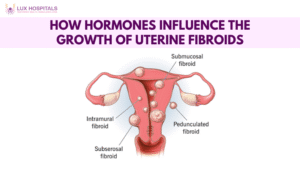Dyspareunia: Understanding Painful Intercourse and What It Means for Your Health

The purpose of sexual intimacy is to provide connection, pleasure, and comfort. But this isn’t always the case for many individuals—especially women. Experiencing pain during sex, known medically as dyspareunia, is a condition that affects both physical and emotional well-being. While it’s more common than you might think, it’s also often misunderstood or unspoken.
Let’s break the silence and discuss definition, signs, symptoms, and possible treatments for dyspareunia.
What Is Dyspareunia?
Persistent pain during or after sexual activity is referred to as dyspareunia. The pain can be felt externally around the genital area or deeper inside the pelvis. For some, it’s a mild discomfort; for others, it can be sharp, burning, or aching making intimacy distressing and even avoidable.
Many people assume painful sex is regular or something to “push through,” but that’s far from the truth. Pain during sex is never something you should ignore. If you’re experiencing this regularly, it’s essential to understand that help is available.
Common Dyspareunia Causes
Understanding the causes of dyspareunia is the first step toward healing. Painful intercourse can arise from a variety of physical or psychological reasons. Some of the most common physical causes include:
- Dry vagina, frequently brought on by hormonal shifts (such as menopause or lactation)
- Urinary tract infections and yeast infections are examples of infections.
- Skin disorders like lichen sclerosis
- Endometriosis is the term for uterine tissue that develops outside the uterus.
- Pelvic inflammatory disease (PID)
- Uterine fibroids or ovarian cysts
- Scarring or trauma, especially after childbirth or surgery
On the psychological side, dyspareunia can be linked to:
- Stress and anxiety
- Relationship issues
- History of sexual trauma or abuse
- Body image concerns or low self-esteem
Because the causes are so varied, identifying the root problem often requires a thorough evaluation by a gynaecologist or pelvic health specialist.
Recognizing Dyspareunia Symptoms
So, what exactly do dyspareunia symptoms look like? They can vary greatly from person to person but commonly include:
- Sharp or burning pain during penetration
- Pain only during deep thrusting
- Discomfort that lingers after sex
- Stinging or irritation in the vaginal area
- Pelvic or lower abdominal pain linked to intercourse
Some individuals may also experience emotional symptoms, such as fear, sadness, or anxiety around intimacy especially if the pain has persisted over time.
Dyspareunia Treatment Options
The good news is that dyspareunia treatment depends on the cause—and it can be managed effectively most of the time. Some of the most common and successful treatment options include:
1. Medical Management
If hormonal changes are the culprit, your doctor might prescribe vaginal estrogen creams, lubricants, or moisturizers. In cases of infection, antibiotics or antifungal medications will be used.
2. Pelvic Floor Physical Therapy
It can be transformative to work with a pelvic floor therapist for those Which discomfort is brought on by pelvic floor dysfunction or tense muscles. To lessen discomfort, these experts assist you in the proper muscular relaxation and strengthening.
3. Psychological Counseling
Since emotional and psychological factors often contribute to dyspareunia, therapy with a sex therapist or counsellor can be an essential part of healing. Therapy can address past trauma, improve communication with a partner, and rebuild a positive relationship with your body.
4. Surgical Intervention
In rare cases, when structural abnormalities, severe endometriosis, or scarring are identified as the root cause, dyspareunia surgery may be recommended. This could involve laparoscopic procedures to remove adhesions or correct anatomical issues.
Why You Shouldn’t Ignore Dyspareunia?
Living with dyspareunia doesn’t just affect your sex life. It can strain relationships, lead to anxiety or depression and reduce your general standard of living. You deserve to feel comfortable in your body and your intimate relationships.
Many people suffer in silence, assuming their pain is unusual or that nothing can be done. But dyspareunia is a legitimate medical condition—and it’s more common than most realize. It’s estimated that up to 20% of women experience pain during sex at some point in their lives.
Talking to Your Doctor About Dyspareunia
If you suspect you may be experiencing dyspareunia, start by having an open and honest conversation with your healthcare provider. Don’t be afraid or embarrassed—your doctor is there to help, not to judge. Describe your symptoms clearly, including:
- When the pain began
- Where you feel the pain
- Whether it happens every time or only occasionally
- Any other symptoms, like bleeding or itching
A thorough pelvic exam and history can help your doctor determine whether further testing, imaging or a referral to a specialist is necessary.
Living Well with Dyspareunia
Managing dyspareunia is more than just medical treatments—it’s also about self-care, support, and open communication with your partner. Here are a few tips to help along the way:
- Use water-based lubricants to reduce friction.
- Take time for foreplay to ensure arousal and natural lubrication.
- Explore non-penetrative forms of intimacy.
- Practice mindfulness and relaxation techniques
- Join a support group or connect with others who understand your experience.
Healing from dyspareunia takes time and patience, but with the proper care and approach, many people go on to enjoy fulfilling, pain-free sex lives.
Conclusion
Dyspareunia is a deeply personal issue, but it’s also a very real medical concern. Whether the cause is physical, emotional, or both, help is available—and recovery is possible. If you’re experiencing painful intercourse, know that you’re not alone, and you don’t have to live in silence.
At Lux Hospitals, our specialists offer compassionate care tailored to your needs. We support your journey toward wellness and confidence, from diagnosis to dyspareunia treatment—and even dyspareunia surgery when needed.
Frequently Asked Questions
Common dyspareunia causes include vaginal dryness, infections, endometriosis, pelvic inflammatory disease (PID), skin conditions, hormonal changes, as well as psychological elements like anxiety or traumatic experiences.
While dyspareunia isn’t life-threatening, it can significantly affect a person’s emotional, mental, and sexual well-being. It frequently signals a health problem that has to be addressed by a physician.
For diagnosis, a complete medical and sexual history is typically needed, a physical and pelvic exam, and sometimes additional tests like swabs, ultrasounds, or pelvic imaging to identify the root cause.
Yes, in many cases, dyspareunia can be effectively treated or managed. Addressing the underlying cause, whether physical or psychological, often leads to significant relief or complete resolution of symptoms.
Temporary pain after childbirth is common, especially if there are tears or stitches. However, if pain persists for months, it could be dyspareunia and medical advice should be sought.
Yes, though less common, men can also experience pain during or after intercourse. The causes in men differ and may include infections, skin conditions, or psychological issues.
If you experience pain during sex regularly, or if it interferes with your quality of life or relationships, consult a gynaecologist or pelvic health specialist. Early evaluation can lead to faster, more effective dyspareunia treatment.




















